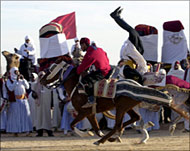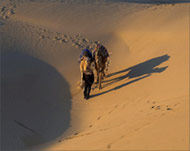Festival relives Bedouin heritage
Somewhere between the dunes and oases of southern Tunisia, where urban life once seduced Bedouin nomads into settling down, a festival has been giving a glimpse of a not-so-distant past.

The 36th International Sahara Festival, held 600km south of Tunis in the city of Douz over the weekend, drew locals and tourists alike for a cultural event that celebrates the region’s heritage and desert peoples.
At the opening ceremony, the city’s wide Hnaiech Square was filled with swarms of turbaned men eager to get a look at a parade of camel riders who, wearing colourful scarves and sitting sidesaddle, led a throng of participants from Africa, the Middle East, Europe, and Asia.
Billed as a not-to-be missed event for desert aficionados, the festival has drawn people from 24 countries to participate in a variety of cultural events, races, and re-enactments of life as it once was in the Sahara.
Many of the artists and jockeys come from desert countries such as Algeria, Egypt, Kuwait, Niger and Sudan, although participants have also journeyed France, Italy, Belgium, Germany, Russia, and even South Korea.
Mix of cultures
The events reflect a great mixture of cultures. Flutes and drums from the Sahara mix with melodies coming from French peasant instruments, and Saluki dogs glare at their Italian greyhound rivals in anticipation of the rabbit hunt.
 |
|
Acrobatic horse riders performing |
Elsewhere, Dabke dancers cross paths with the local Douz Bedouin footwork.
Up in the wind-swept grandstands, thousands of locals and tourists follow the parade.
Riders wearing red satin shirts and baggy black pants handle their mounts like acrobats, spinning round and firing off shots in the air from their Barb and Arabic horses.
Eighteen-year old Marwan, a professional rider who performs for traditional marriage ceremonies with a folkloric troupe, calls his horse his “bread winner”.
A descendant of the great Marzougui tribe of nomads, he carries a sabre instead of a ceremonial rifle, which, he regrets, is “too rare and too expensive”.
Nomadic life
Real nomad life, however, has all but disappeared from the area, and few people now live full time in the desert.
Today, Douz is a city whose fate is very much linked to the Sahara tourist industry and the nomads to which it is home are of a decidedly part-time variety.
 |
|
Nomad life has all but disappeared |
Mohammad Maamun, a well-to-do fifty-something Marzougui tribesman living in Douz, plans on living under a tent when he moves to the desert in February with his family and livestock.
M’Barka, a 65 year-old woman operating a weaving machine for camel-hair fabric, is also heading to the desert to organize a Bedouin re-enactment tent village – during the festival.
“We only go to the desert for a couple of days,” she said nostalgically, adding that she also makes the trip “during school vacation, to breathe a bit of air from beyond the city walls”.
When the desert sun finally goes down, the festival ends for the night.
Apart from the few people staying in tents, most of the crowd goes indoors to sleep.
And for those going farther than a camel can carry them, the Sahara today is no stranger to the four-wheel drive.